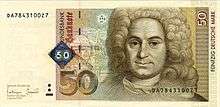Balthasar Neumann
| Johann Balthasar Neumann | |
|---|---|
 | |
| Born |
January 27, 1687 Eger, Bohemia, Holy Roman Empire |
| Died |
August 19, 1753 (aged 66) Würzburg, Lower Franconia, Holy Roman Empire |
| Occupation | Architect |
| Buildings | Würzburg Residence, Basilica of the Fourteen Holy Helpers |
Johann Balthasar Neumann (![]() listen ; 27 January 1687 – 19 August 1753), usually known as Balthasar Neumann, was a German architect and military artillery engineer who developed a refined brand of Baroque architecture, fusing Austrian, Bohemian, Italian, and French elements to design some of the most impressive buildings of the period, including the Würzburg Residence and the Basilica of the Fourteen Holy Helpers, called Vierzehnheiligen in German.
listen ; 27 January 1687 – 19 August 1753), usually known as Balthasar Neumann, was a German architect and military artillery engineer who developed a refined brand of Baroque architecture, fusing Austrian, Bohemian, Italian, and French elements to design some of the most impressive buildings of the period, including the Würzburg Residence and the Basilica of the Fourteen Holy Helpers, called Vierzehnheiligen in German.
The Würzburg Residence is considered one of the most beautiful and well proportioned palaces in Europe and the Basilica of the Fourteen Holy Helpers is considered by some as the crowning work of the period.
Neumann was an architect of St. Paulinus' Church in Trier, designing most of the internal elements. His final work is the Church of the Visitation of Mary, a masterpiece of the Baroque style located near Eltmann am Main.
Early life
Neumann was born in house No. 12 on Schiffgasse street, Eger, Kingdom of Bohemia, now known as Cheb, Czech Republic, the seventh of nine children of cloth-maker Hans Christoph Neumann. He was baptized on 30 January 1687.
His first apprenticeship was spent working at the foundry of his godfather Balthasar Platzer, but he changed at the beginning of the 18th century to Sebald Koch in Würzburg where, in 1711, he received his apprenticeship certificate. In 1712, he joined the Franconian artillery as a private because this was the only path to follow for Neumann to have a military career as an engineer. He perfected his skills through studies in the field of fortress architecture.
Würzburg
In 1714 Neumann entered into the service of the Prince-Bishopric of Würzburg, or secular authority (Hochstift). In 1717 and 1718, he was with the Franconian troops in Austria and Hungary where he worked as an engineer in their Belgrade detachment.
In Vienna he became acquainted with the Baroque buildings of Johann Bernhard Fischer von Erlach and Johann Lucas von Hildebrandt, training himself in their style. On a trip to Milan he encountered the works of Guarino Guarini, which inspired Neumann's future projects.
In 1715, Neumann had already emerged as a rising talent and come to the notice of the Elector of Mainz, Lothar Franz von Schönborn. After a period of time under the direction of the Würzburg architect Andreas Müller and Joseph Greising, in 1719, Lothar Franz's nephew, the newly appointed Prince-Bishop of Würzburg, Johann Philipp von Schönborn, appointed Neumann the chief engineer in Würzburg. Neumann took this position in 1720 after all the planning for the construction of the Würzburg Residence.
He died in Würzburg on 19 August 1753 and is buried at the Marienkapelle there.

Legacy
A picture of him could be seen on the former 50 DM note together with the famous staircase located in the Residence of Würzburg. Neumann was also depicted by Tiepolo in the ceiling fresco above the stairway of the Residence, in pseudo-military uniform, leaning over a cannon. He had boasted that the ceiling was so well constructed that not even the roar of a cannon would make the roof fall.
References
Further reading
- Manuel Weinberger: "Verschollen geglaubtes Planmaterial von Balthasar Neumann und seinem Baubüro, und eine unbekannte Zeichnung aus dem Umfeld Johann Dientzenhofers", in: RIHA Journal 0003 [14 April 2010], http://www.riha-journal.org/articles/2010/weinberger-planmaterial-balthasar-neumann (accessed 15 April 2010).
External links
- Biography at NDB
- Johann Balthasar Neumann featured on the 50 Deutsche Mark banknote from 1991.
- Encyclopedia of World Biography
| Wikimedia Commons has media related to Balthasar Neumann. |